Above: Girls scramble for a rebound in action from a six-on-six game between Menlo and Huxley. The date of the vintage photo is unknown, but aren’t the fashion and action delightfully intense?
Writer: Jane Burns
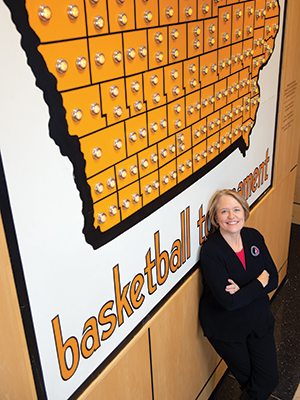
When Jean Berger played basketball at Winterset High School in the 1970s, she’d regularly score 30 or 40 points a game, a feat seemingly so eyebrow-raising that years later it even impressed her daughters.
And as awesome as it would be for any parent to accomplish something that could wow their kids, it turns out the feat by the woman who is now the executive director of the Iowa Girls High School Athletic Union wasn’t so very impressive after all.
“It was Iowa, it wasn’t anything for people to average 60 points a game,” Berger says of the famous six-on-six girls’ game that allowed just three players on each team to score. “In the old days, the Register would publish a list of the state’s top scorers every week and if I scored 42 points, it didn’t even make the Big Peach.”
That combination of mundane and extraordinary is what makes girls’ sports in Iowa so exceptional, and few know that better than Berger. She leads a sports organization that has been around for nearly a century, one that is hosting a basketball tournament for the 100th time right now, as this issue of dsm magazine is being mailed to subscribers. In Iowa, that 100th anniversary can seem like no big deal because the girls’ tournament is as quintessentially Iowan as a corn dog at the State Fair. To the rest of the country, it’s an almost unbelievable anniversary—one shared by a little team called the Green Bay Packers, which just celebrated its 100th season.
“It’s nuts, to put it in perspective,” says Janel (Grimm) Burgess, a former Iowa State basketball star who coached her alma mater, Montezuma High School, to the tournament last year.
In a sports landscape where most places didn’t even think about sports for girls until Title IX passed in 1972, Iowa’s proud past doesn’t ensure future success. That’s the job of Berger, 60, who became the organization’s first female executive director in 2016. Her task is to bring touches of what modern-day high school kids might want and need along with a mission to help them remember that they are part of a unique history.
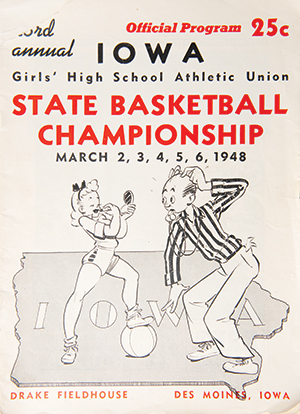
Iowa Girl
“I don’t want the Iowa Girl to ever think she’s not important, and we have a long tradition of her being important,” says Berger, whose organization is the only one in the U.S. dedicated solely to girls’ high school sports.
Berger herself is an “Iowa Girl,” a term the girls’ union has used and now hashtags as a way to acknowledge a quote from E. Wayne Cooley, who led the organization from 1954 to 2002: “I take a lot of pride that every girl walks down every main street in every town in Iowa just as tall as the boy.”
“It’s been really neat to see Jean take it over and bring her influence,” says Jan Jensen, associate head basketball coach at the University of Iowa and a member of the athletic union’s basketball hall of fame. “I think she’s doing a great job of keeping all that is good and wonderful and awesome about the Iowa Girl, but she has the confidence to stretch it a bit and make the necessary changes.”
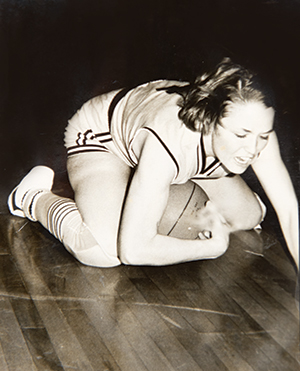
If you take a trip to the state basketball tournament, or to any number of events within the 10 sports the union sanctions (see list, at right), there is still the familiar environment for those who have followed the games for years. Yet there are touches that bring it into the modern era. Berger has increased the union’s branding efforts—the pink from the organization’s longtime logo is ever-present in ways beyond signage, from the “pink carpet” that athletes walk to the shoes on Berger’s feet. Anytime a girl qualifies for a state tournament, as a team or individual, she is photographed holding a placard that says “Ticket Punched”—an image custom-made for social media and a scrapbook. She’s working to move corporate partnerships beyond hanging up a nice sign at an event into something more meaninful, like the concussion insurance for athletes now funded by the Iowa Farm Bureau.
“It’s neat to have a union that is led by strong women who can put together a tournament, and a space, where there is something special for the girls,” Burgess says. “It’s something Iowa should be extremely proud of.”
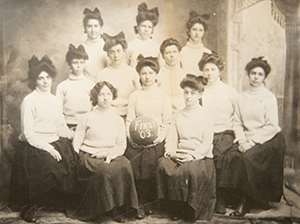
Lack of Equality
That sense of equality for girls was something Berger took for granted in high school, only to learn it wasn’t the case away from the comfort of small-town Iowa. She was flabbergasted when she took her interests in sports and writing to the University of Iowa and began to learn the finer points of athletic communications—and inequality—in the burgeoning world of women’s collegiate athletics.
“Everything was different, from how they traveled in their own cars to buying their own uniforms,” Berger says of the late 1970s and early ’80s Hawkeye women’s teams for whom she kept statistics, wrote press releases and reported scores to local media. “I never dreamed a team would have a coach who didn’t get paid. I never paid a dime in high school to play and then I found out girls at Iowa had to buy their own uniforms.”
Reaching out to media and pitching stories about female athletes made up the early part of her career, including in the Drake athletic communications office. It got easier over the years, as her job at Drake included working with the women’s basketball team when Lisa Bluder, now at Iowa, was having great success with the Bulldogs. Berger moved up the ladder at Drake to become associate athletic director and took a similar position at the University of Northern Iowa. She served on the powerful NCAA women’s basketball and volleyball committees, which oversee the sports and select the tournament teams.
Though on track to possibly take over the top job at Northern Iowa, Berger was intrigued by the possibility of leading the girls’ athletic union. The organization began in 1927 when there was a difference of opinion among school superintendents in the state, and nationwide, about the suitability of athletics for girls. Many superintendents had already seen the success of the girls’ basketball tournament that had been running for a few years and had no reason to think sports were bad for girls. So those who supported girls’ sports broke away from the Iowa High School Athletic Association and formed the Iowa Girls High School Athletic Union.
Nearly 90 years later, Berger became the first woman to run the organization.
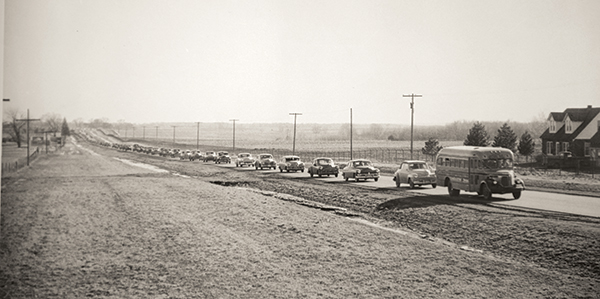
Focusing On the Girl
“I think the biggest part for me is I get to specialize in one thing—the girl,” Berger says. “I don’t have to worry about what football is doing, I don’t have to worry about code of conduct, I don’t have to worry about some bill that didn’t get paid. I just worry about the Iowa Girl. That part is awesome.”
The boys’ and girls’ organizations live in harmony, and co-host the state track meet. When there is a change at the top of either organization, there is usually scuttlebutt that they will merge. Berger doesn’t see that happening anytime soon.
“Girls come into sports for a different reason and they stay for a different reason,” Berger says. “It’s so valuable in terms of their self-esteem, their confidence, what it gives them that they use later in life.”
With a merger, Berger says, “I think it’s really shortsighted to think it would be the same. It would change, and girls would be the ones most hurt. And for the boys, it would dilute what they get, too.”
Berger is just getting started, with myriad challenges remaining. How can schools develop and retain female coaches? What will the television landscape look like in five years? How can her organization emphasize the things girls get from sports that have nothing to do with a college scholarship? What other sports might girls want to play in high school?
“We’re here to call attention to the Iowa Girl, and to make it her experience,” Berger says. “If we get out of the way, it will change her life for the better.”
The Iowa Girls High School Athletic Union sanctions these 10 sports:
Basketball
Bowling
Cross-Country
Swimming and Diving
Golf
Softball
Soccer
Tennis
Track and Field
Volleyball









Show Comments (1)
George Hesselberg
Excellent, timely and well-written article, with great photos. And universally-applicable quotes: “I take a lot of pride that every girl walks down every main street in every town in Iowa just as tall as the boy.” Nicely done.
Comments are closed.